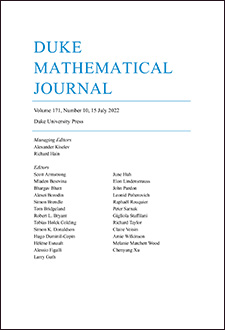Abstract
The first nontrivial zeros of the Riemann $zeta$-function are $\approx1/2\pm 14:13472i$. We investigate the question of whether or not any other $L$-function has a higher lowest zero. To do so, we try to quantify the notion that the $L$-function of a "small" automorphic representation (i.e., one with small level and archimedean type) does not have small zeros, and vice-versa. We prove that many types of automorphic $L$-functions have a lower first zero than $\zetas$'s (see Theorems 1.1 and 1.2). This is done using Weil's explicit formula with carefully chosen test functions. When this method does not immediately show that $L$-functions of a certain type have low zeros, we then attempt to turn the tables and show that no $L$-functions of that type exist. Thus, the argument is a combination of proving that low zeros exist and that certain cusp forms do not. Consequently, we are able to prove vanishing theorems and improve upon existing bounds on the Laplace spectrum on $L\sp 2({\rm SL}\sb n(\mathbb {Z})\backslash{\rm SL}\sb n(\mathbb {R})/{\rm SO}\sb n(\mathbb {R}))$. These in turn can be used to show that ${\rm SL}\sb 68(\mathbb {Z})\backslash{\rm SL}\sb 68(\mathbb {R})/{\rm SO}\sb 68(\mathbb {R})$ has a discrete, nonconstant, noncuspidal eigenvalue outside the range of the continuous spectrum on $L\sp 2({\rm SL}\sb 68(\mathbb {R})/{\rm SO}\sb 68(\mathbb {R}))$, but that this never happens for ${\rm SL}\sb n(\mathbb {Z})\backslash/{\rm SL}\sb n(\mathbb {R})/{\rm SO}\sb n(\mathbb {R})$ in lower rank. Another application is to cuspidal cohomology: we show there are no cuspidal harmonic forms on ${\rm SL}\sb n(\mathbb {Z})\backslash{\rm SL}\sb n(\mathbb {R})/{\rm SO}\sb n(\mathbb {R})$ for $n<27$.
Citation
Stephen D. Miller. "The highest lowest zero and other applications of positivity." Duke Math. J. 112 (1) 83 - 116, 15 March 2002. https://doi.org/10.1215/S0012-9074-02-11213-7
Information





